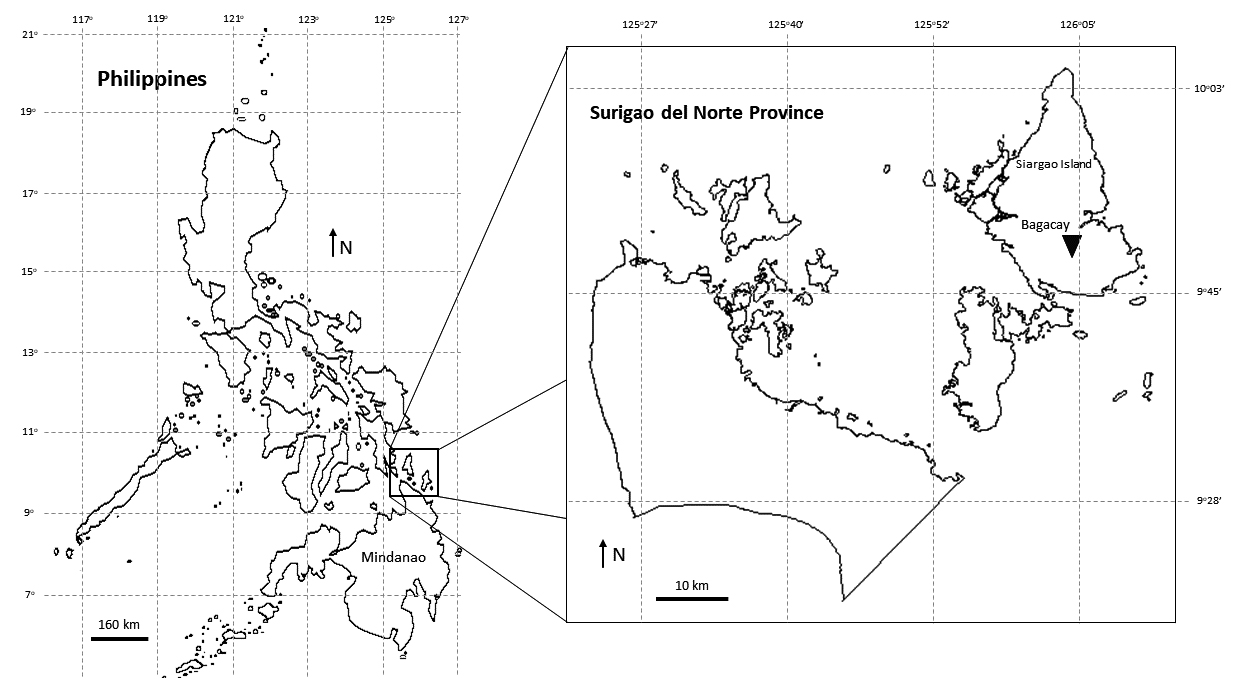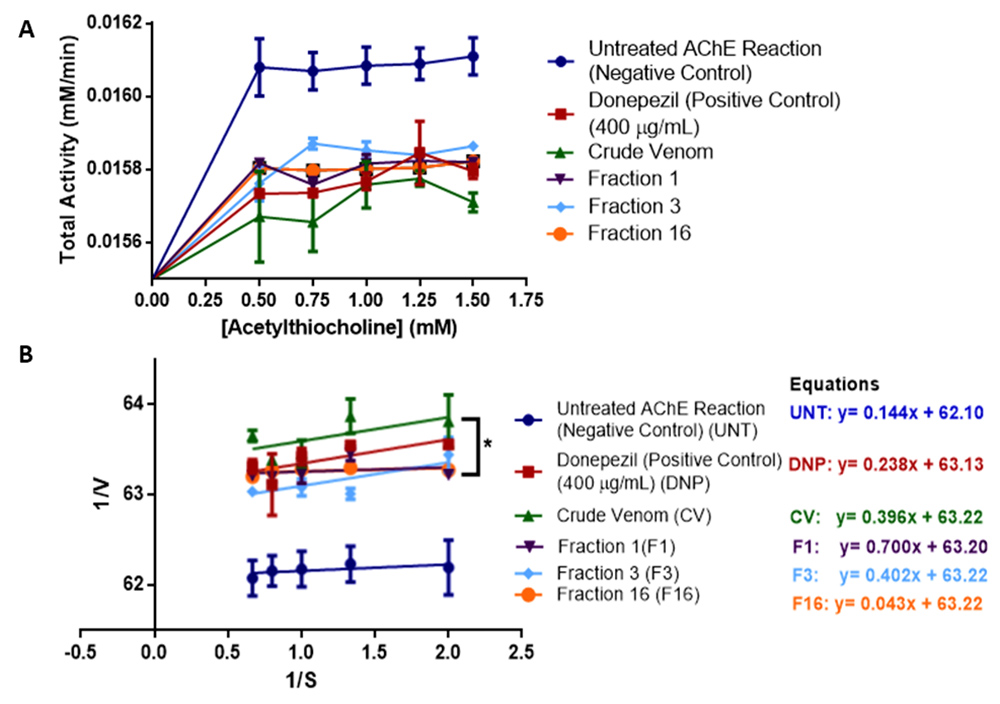| 6 |
37.72 |
1028.33 |
U -ctenitoxin-Pn1c 29 |
1027.57 |
Phoneutria nigriventer
|
Contracts smooth muscle of guinea pig ileum |
Pimenta et al. [57] |
| 7 |
40.555 |
3406.14 |
U -scytotoxin-Sth1a 1 |
3406.36 |
Scytodes thoracica
|
Unknown |
Zobel-Thropp et al. [5858. Zobel-Thropp PA, Correa SM, Garb JE, Binford GJ. Spit and venom from scytodes spiders: a diverse and distinct cocktail. J Proteome Res. 2014;13(2):817-35. doi:10.1021/pr400875s
https://doi.org/10.1021/pr400875s...
] |
| |
|
3410.14 |
κ-sparatoxin-Hv1b |
3410.34 |
Heteropoda venatoria
|
Blocks vertebrate Kv4.x and transient outward VGKC in rat ventricular myocytes; weak blocker of calcium channels in rat cerebellar granule cells |
Sanguinetti et al. [5959. Sanguinetti MC, Johnson JH, Hammerland LG, Kelbaugh PR, Volkmann RA, Saccomano NA, Mueller AL. Heteropadatoxins: peptides isolated from spider venom that block Kv4.2 potassium channels. Mol Pharmacol. 1997;51(3):491-8.] |
| |
|
3428.07 |
M-zodatoxin-Lt5a |
3427.94 |
Lachesana tarabaevi
|
Antimicrobial activity against gram-negative and positive bacteria, and yeasts. It has hemolytic activity against rabbit erythrocytes and causes non- lethal paralysis to Musca domestica larvae |
Kozlov et al. [6060. Kozlov SA, Vassilevski AA, Feofanov AV, Surovoy AY, Karpunin DV, Grishin EV. Latarcins, antimicrobial and cytolytic peptides from the venom of the spider Lachesana tarabaevi (Zodariidae) that exemplify biomolecular diversity. J Biol Chem. 2006;281(30):20983-92. doi:10.1074/jbc.M602168200
https://doi.org/10.1074/jbc.M602168200...
] |
| |
|
4356.94 4357.98 |
U -theraphotoxin-Cg1b 3 |
4357 |
Chilobrachys guagxiensis
|
Unknown |
Chen et al. [6161. Chen J, Deng M, He Q, Meng E, Jiang L, Liao Z, Rong M, Liang S. Molecular diversity and evolution of cystine knot toxins of the tarantula Chilobrachys jingzhao. Cell Mol Life Sci. 2008;65(15):2431-44. doi: 10.1007/s00018-008-8135-x
https://doi.org/10.1007/s00018-008-8135-...
] |
| |
|
4360 |
ω-hexatoxin-Hv2o |
4360.05 |
Hadronyche versuta
|
Insecticidal toxin that blocks insect VGCC |
King and Wang [6262. King GF, Wang X, inventors; University of Connecticut, applicant. Insecticidal compounds and methods for selection thereof. Australia patent AU2001238152. May 10, 2011.] |
| |
|
4362.04 |
ω-hexatoxin-Hv2i |
4362.03 |
Hadronyche versuta
|
Insecticidal toxin that blocks insect VGCC |
King and Wang [6262. King GF, Wang X, inventors; University of Connecticut, applicant. Insecticidal compounds and methods for selection thereof. Australia patent AU2001238152. May 10, 2011.] |
| |
|
|
ω-theraphotoxin-Bs1b |
4362.23 |
Brachypelma smithi
|
Unknown |
Escoubas et al. [6363. Escoubas P, Célérier M, Nakajima T. High-performance liquid chromatography matrix-assisted laser desorption/ionization time-of-flight mass spectrometry peptide fingerprinting of tarantula venoms in the genus Brachypelma: chemotaxonomic and biochemical applications. Rapid Commun Mass Spectrom. 1997;11(17):1891-9. doi: 10.1002/(SICI)1097-0231(199711)11:17<1891::AID-RCM94>3.0.CO;2-X.[64.
https://doi.org/10.1002/(SICI)1097-0231(...
] |
| |
|
4380.98 |
ω-theraphotoxin-Asp1a |
4380.2 |
Aphonopelma sp.
|
Inhibits rat cerebellar granule VGCC |
Nason et al. [6464. Nason DM, Phillips D, Saccomano NA, Volkmann RA, inventors; Pfizer Inc. NPS Pharmaceuticals Inc., applicants. Calcium channel blocking polypeptides from Theraphosidae Aphonopelma. International patent WO 94/10196. May 11, 1994. Available from: https://patentimages.storage.googleapis.com/30/b7/58/042d09da06b2d6/WO1994010196A1.pdf.
https://patentimages.storage.googleapis....
] |
| 8 |
43.324 |
3792.65 |
U -agatoxin-Ao1d 2 |
3792.73 |
Agelena orientalis
|
Unknown |
Kozlov et al. [6565. Kozlov S, Malyabka A, McCutchen B, Lu A, Schepers E, Herrmann R, Grishin E. A novel strategy for the identification of toxinlike structures in spider venom. Proteins. 2005;59(1):131-40. doi:10.1002/prot.20390
https://doi.org/10.1002/prot.20390...
] |
| |
|
3901.81 |
U -agatoxin-Ao1l 2 |
3901.76 |
Agelena orientalis
|
Unknown |
Kozlov et al. [6565. Kozlov S, Malyabka A, McCutchen B, Lu A, Schepers E, Herrmann R, Grishin E. A novel strategy for the identification of toxinlike structures in spider venom. Proteins. 2005;59(1):131-40. doi:10.1002/prot.20390
https://doi.org/10.1002/prot.20390...
] |
| 9 |
44.143 |
3788.53 |
U -agatoxin-Ao1j 2 |
3788.7 |
Agelena orientalis
|
Unknown |
Kozlov et al. [6565. Kozlov S, Malyabka A, McCutchen B, Lu A, Schepers E, Herrmann R, Grishin E. A novel strategy for the identification of toxinlike structures in spider venom. Proteins. 2005;59(1):131-40. doi:10.1002/prot.20390
https://doi.org/10.1002/prot.20390...
] |
| |
|
3792.56 |
U -agatoxin-Ao1d 2 |
3792.73 |
Agelena orientalis
|
Unknown |
Kozlov et al. [6565. Kozlov S, Malyabka A, McCutchen B, Lu A, Schepers E, Herrmann R, Grishin E. A novel strategy for the identification of toxinlike structures in spider venom. Proteins. 2005;59(1):131-40. doi:10.1002/prot.20390
https://doi.org/10.1002/prot.20390...
] |
| |
|
3793.64 |
ω-hexatoxin-Ar1b |
3793.51 |
Atrax robustus
|
Blocks insect VGCC |
King et al. [6666. King GF, Mukherjee AK, Wikel SK, McFarland BS, inventors. University of Connecticut, assignee. Acaricidal compostions and methods of use therof. United States patent US7,575,758B2. August 18, 2009. Available from: https://patentimages.storage.googleapis.com/d3/dc/16/1cd5c910cbb80f/US7575758.pdf.
https://patentimages.storage.googleapis....
] |
| |
|
3805.59 |
U -theraphotoxin-Hs1b 20 |
3805.69 |
Haplopelma schimidti
|
Unknown |
Zhang et al. [6767. Zhang Y, Huang Y, He Q, Liu J, Luo J, Zhu L, Lu S, Huang P, Chen X, Zeng X, Liang S. Toxin diversity revealed by a transcriptomic study of Ornithoctonus huwena. PloS ONE. 2014;9(6). doi:10.1371/journal.pone.0100682
https://doi.org/10.1371/journal.pone.010...
] |
| |
|
3808.75 |
U -theraphotoxin-Cg1a 15 |
3808.73 |
Chilobrachys guagxiensis
|
Unknown |
Chen et al. [6868. Huang RH, Liu ZH, Liang SP. Purification and characterization of a neurotoxic peptide huxentoxin-III and a natural inactive mutant from the veom of the spider Selenocosmia huwena Wang (Ornithoctonus huwena Wang). Sheng Wu Hua Xue Yu Sheng Wu Wu Li Xue Bao (Shanghai). 2003 Nov;35(11):976-80.] |
| 10 |
45.768 |
3849.67 |
μ-theraphotoxin-Hs1a |
3849.66 |
Haplopelma schimidti
|
Blocks insect sodium channels in cockroach DUM neurons; reversibly paralyzes cockroaches and enhances the muscular contractions of rat vas deferens |
Huang et al. [6868. Huang RH, Liu ZH, Liang SP. Purification and characterization of a neurotoxic peptide huxentoxin-III and a natural inactive mutant from the veom of the spider Selenocosmia huwena Wang (Ornithoctonus huwena Wang). Sheng Wu Hua Xue Yu Sheng Wu Wu Li Xue Bao (Shanghai). 2003 Nov;35(11):976-80.] |
| |
|
3850.49 |
U -theraphotoxin-Hhn1q 3 |
3850.61 |
Haplopelma hainanum
|
Unknown |
Tang et al. [6969. Tang, X, Zhang, Y, Hu, W, Xu D, Tao H, Yang X, Li Y, Jiang L, Liang S. Molecular diversification of peptide toxins from the tarantula Haplopelma hainanum (Ornithoctonus hainana) venom based on transcriptomic, peptidomic, and genomic analyses. J Proteomeo Res. 2010;9(5):2550-64. doi: 10.1021/pr1000016
https://doi.org/10.1021/pr1000016...
] |
| |
|
3850.97 |
U -theraphotoxin-Hhn1e 3 |
3850.61 |
Haplopelma hainanum
|
Unknown |
Tang et al. [6969. Tang, X, Zhang, Y, Hu, W, Xu D, Tao H, Yang X, Li Y, Jiang L, Liang S. Molecular diversification of peptide toxins from the tarantula Haplopelma hainanum (Ornithoctonus hainana) venom based on transcriptomic, peptidomic, and genomic analyses. J Proteomeo Res. 2010;9(5):2550-64. doi: 10.1021/pr1000016
https://doi.org/10.1021/pr1000016...
] |
| |
|
3862.69 |
U -agatoxin-Ao1s 2 |
3862.86 |
Agelena orientalis
|
Unknown |
Kozlov et al. [6565. Kozlov S, Malyabka A, McCutchen B, Lu A, Schepers E, Herrmann R, Grishin E. A novel strategy for the identification of toxinlike structures in spider venom. Proteins. 2005;59(1):131-40. doi:10.1002/prot.20390
https://doi.org/10.1002/prot.20390...
] |
| 11 |
47.819 |
3404.92 |
U -theraphotoxin-Cv1a 1 |
3404.43 |
Coremiocnemis valida
|
Unknown |
Balaji et al. [7070. Balaji RA, Sasaki T, Gopalakrishnakone P, Sato K, Kini RM, Bay BH. Purification, structure determination and synthesis of covalitoxin-II, a short insect-specific neurotoxic peptide from the venom of Coremiocnemis Validus (Singapore tarantula). FEBS Lett. 2000;474(2-3):208-12. doi: 10.1016/s0014- 5793(00)01593-3
https://doi.org/10.1016/s0014- 5793(00)0...
] |
| Whole venom |
- |
3595.56 |
κ-sparatoxin-Hv1c |
3596.46 |
Heteropoda venatoria
|
Blocks vertebrate Kv4.x and transient outward VGKC in rat ventricular myocytes; weak blocker of calcium channels in rat cerebellar granule cells |
Sanguinetti et al. [5959. Sanguinetti MC, Johnson JH, Hammerland LG, Kelbaugh PR, Volkmann RA, Saccomano NA, Mueller AL. Heteropadatoxins: peptides isolated from spider venom that block Kv4.2 potassium channels. Mol Pharmacol. 1997;51(3):491-8.] |
| |
|
3788.46 |
U -agatoxin-Ao1j 2 |
3788.7 |
Agelena orientalis
|
Unknown |
Kozlov et al. [6565. Kozlov S, Malyabka A, McCutchen B, Lu A, Schepers E, Herrmann R, Grishin E. A novel strategy for the identification of toxinlike structures in spider venom. Proteins. 2005;59(1):131-40. doi:10.1002/prot.20390
https://doi.org/10.1002/prot.20390...
] |
| |
|
|
κ-theraphotoxin-Sc1a |
3788.57 |
Stromatopelma calceatum
|
Blocks Kv4.2, Kv2.2 and Kv2.1 in vertebrates |
Shiau et al. [7171. Shiau YS, Huang PT, Liou HH, Liaw YC, Shiau YY, Lou KL. Structural basis of binding and inhibition of novel tarantula toxins in mammalian voltage-dependent potassium channels. Chem Res Toxicol. 2003;16(10): 1217-25. doi: 10.1021/tx0341097.
https://doi.org/10.1021/tx0341097....
] |
| |
|
4051.5 |
M-theraphotoxin-Gr1d |
4051.93 |
Grammostola rosea
|
Antimicrobial and atrial fibrillation activity by blocking KvAP; blocks mechanosensitive ion channels |
Kimura et al. [7272. Kimura T, Ono S, Kubo T. Molecular cloning and sequence analysis of the cDNAs encoding toxin like peptides from the venom glands of tarantula Grammostola rosea. Int J Peptides. 2012;1-12. doi: 10.1155/2012/731293
https://doi.org/10.1155/2012/731293...
] |

 Thumbnail
Thumbnail
 Thumbnail
Thumbnail
 Thumbnail
Thumbnail
 Thumbnail
Thumbnail
 Thumbnail
Thumbnail
 Thumbnail
Thumbnail
 Thumbnail
Thumbnail
 Thumbnail
Thumbnail
 Thumbnail
Thumbnail








